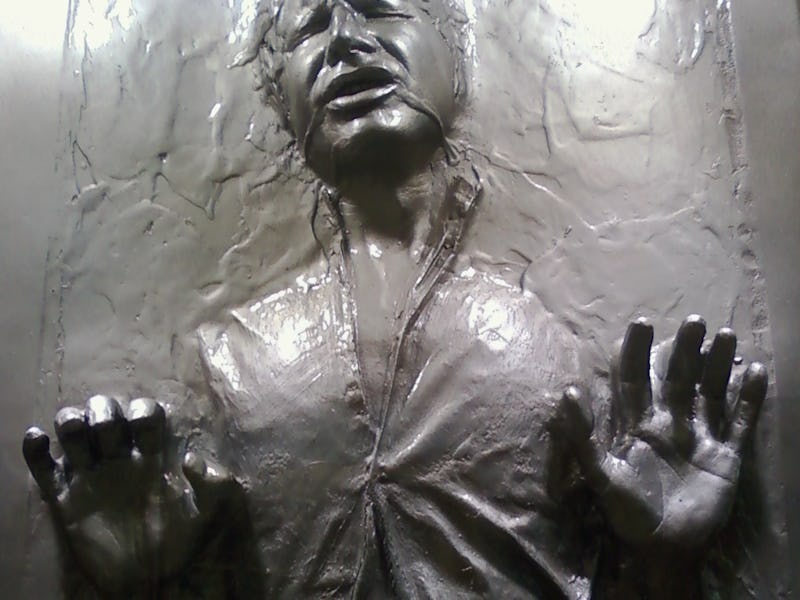How Would the Human Body Respond to Carbonite Freezing?
Let's just say Han Solo got lucky.

In one of the most iconically frustrating scenes in all of modern cinema, Han Solo gets frozen in carbonite at the end of Star Wars: Episode V — The Empire Strikes Back. The carbonite chamber fills with clouds of thick, white vapor as Han Solo, his face scrunched up in anxious anticipation, disappears in the carbonite gas. And while the feelings we feel during that famous scene are real, carbonite freezing is (currently) not.
But what if it were? Could our hero survive the freezing process? And if so, could he be successfully thawed? We spoke to cryonics expert Ben Best to find out. He hasn’t seen Empire, but he says carbonite freezing seems similar in principle to cryonic preservation, in which human bodies are preserved at extremely low temperatures.
“That sounds very similar to what is actually being done in practice by cryonics organizations,” Best, the former president and CEO of the Cryonics Institute, tells Inverse. Much like carbonite freezing, cryopreservation involves cooling a body from the outside. Unlike carbonite freezing, though, cryopreservation is a gradual process, involving some very specific precautions meant to help protect the sensitive tissues of the human body against the harm that can occur during freezing. In fact, Best doesn’t even like to use the word “freeze” to describe cryonics.
“The patient is cooled down, and their blood is replaced,” he explains. “The water in their body is actually replaced with a vitrification solution to prevent ice formation so that the tissues harden like glass rather than freeze.”
This might hurt.
This process of vitrification is key to cryonics, allowing the human body to cool without experiencing the cell damage that can accompany crystallization. To put it crudely, think of freezer burn but inside of you. Cryonics companies avoid freezing by replacing a patient’s blood with a cryoprotectant, a liquid that will become viscous as it cools but won’t form crystals that could damage the tender cells and tissues of the human body.
Here’s the thing, though: The carbon freezing chamber in Cloud City didn’t utilize any sort of cryoprotectants because, unlike in other cinematic depictions of cryogenic sleep, it wasn’t made to preserve humans. Lando Calrissian’s mining facility was set up to process tibanna gas and encase it in blocks of carbonite so it could be shipped safely. This highly reactive substance, used to power starship blasters, needed to be stabilized for transport but didn’t share humanoids’ unique biological needs. As such, it was fortunate that Han Solo survived freezing in the first place.
Darth Vader, who experienced carbonite freezing in his younger years, probably knew it was safe, but the fact remains that it definitely wasn’t designed for living beings.
Neither is cryopreservation, though. “This process isn’t currently applied to living people,” says Best. “They have to be legally dead, as far as cryonics is concerned. There’s some talk of doing it to a living person, but it’s not reversible by current technology.” Typically, a person is cryogenically preserved immediately after death. The hope is that science will advance to the point that eventually humans will find a cure for whatever ailment killed the person, whether it’s cancer, congenital illnesses, or traumatic injuries. At that point, a patient could be reanimated and healed.
As far as reanimating a cryopreserved human, well, the hope is that scientists will find a way to do that, too, as there is currently no way to safely warm human tissue back up. Even if human tissue is successfully vitrified without any crystals forming, crystals almost always form during warming. Best explains that part of the problem is that cryoprotectants are too toxic to use in sufficient quantities to fully protect human tissue. And while scientists are working on developing less toxic cryoprotectants, they’re not quite there yet.
So much for Han Solo?
So even if Han Solo somehow survived carbonite freezing without his bodily fluids crystallizing and turning his body into a huge mass of destroyed cells, it is highly unlikely that he would be reanimated without suffering cell damage. Granted, crystallization could theoretically be avoided if a cryopreserved body was brought back up to temperature tens or hundreds of times faster than it was cooled. It also must be warmed uniformly, a huge challenge when dealing with a human body, which is made up of many types of tissues. So it’s possible that the intensely bright light that emanates from the carbonite block during Han Solo’s thawing is the byproduct of an advanced warming technology. But since the machine in which he was frozen isn’t intended for humans, this seems highly unlikely.
Strangely, one of the most notable effects of Han Solo’s hibernation sickness was blindness, whereas corneas are one of the only human organs that scientists actually have been able to successfully vitrify and warm.
So, while it may come as little surprise that a space opera didn’t quite hit the mark in terms of scientific accuracy, perhaps it’s fitting that Han Solo, a pilot known for defying all odds, survived a procedure that should have killed him.